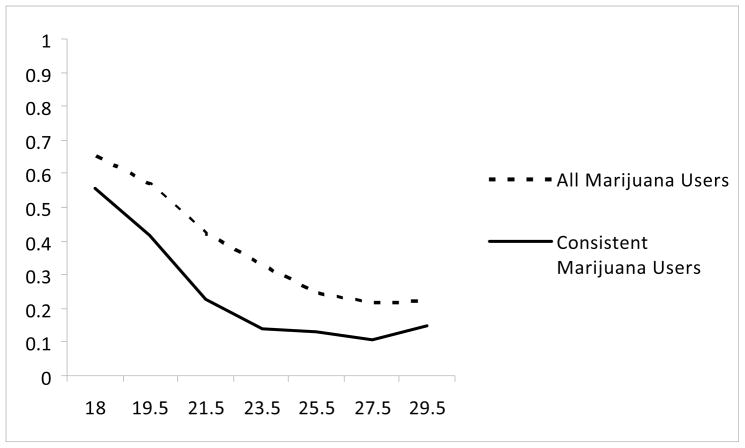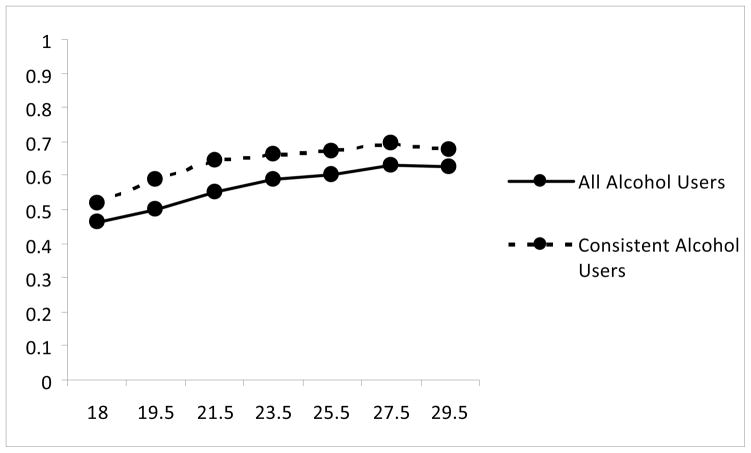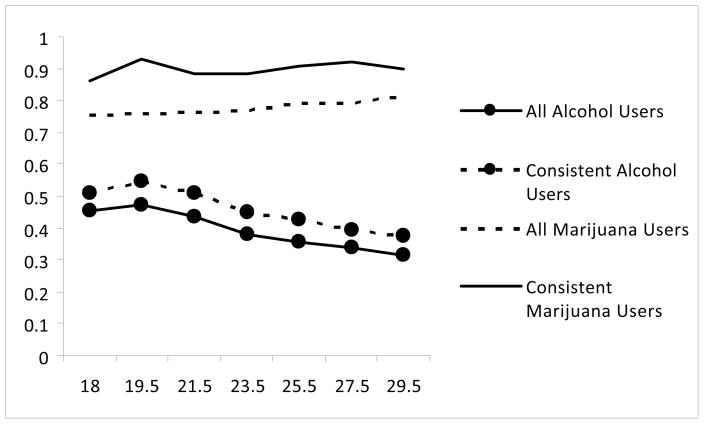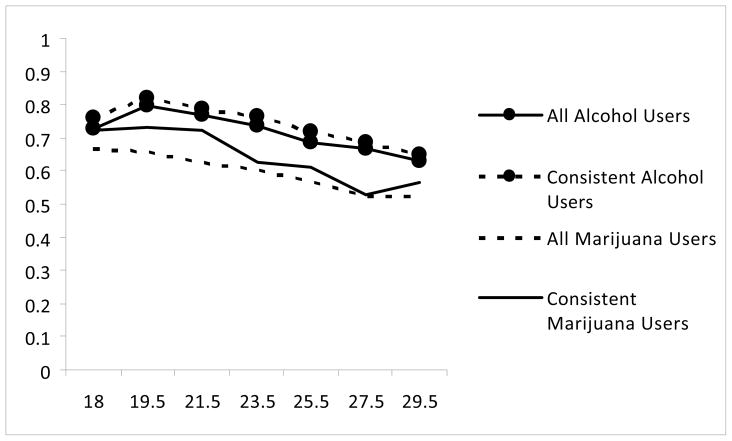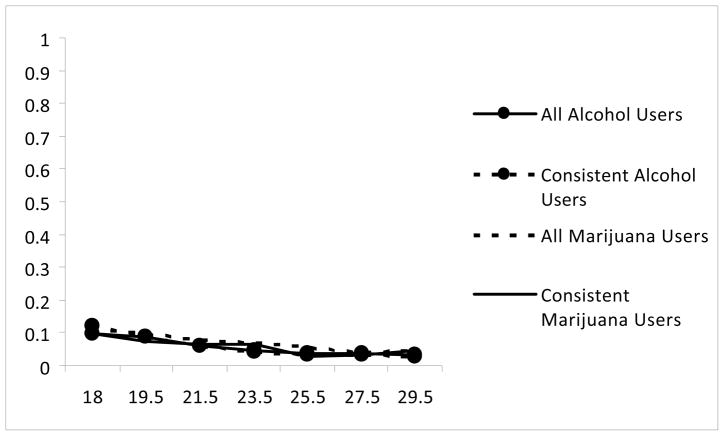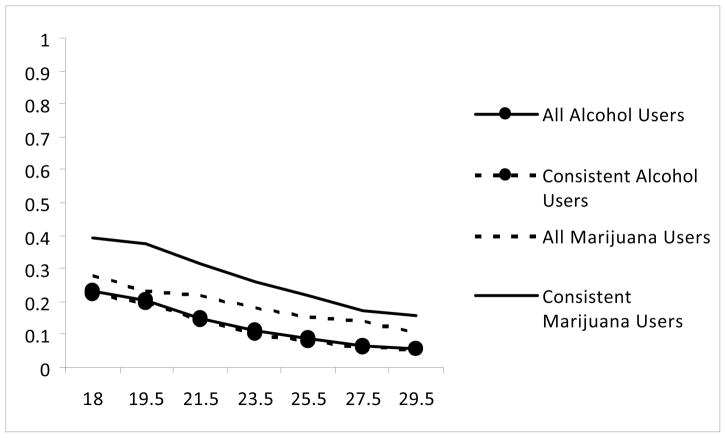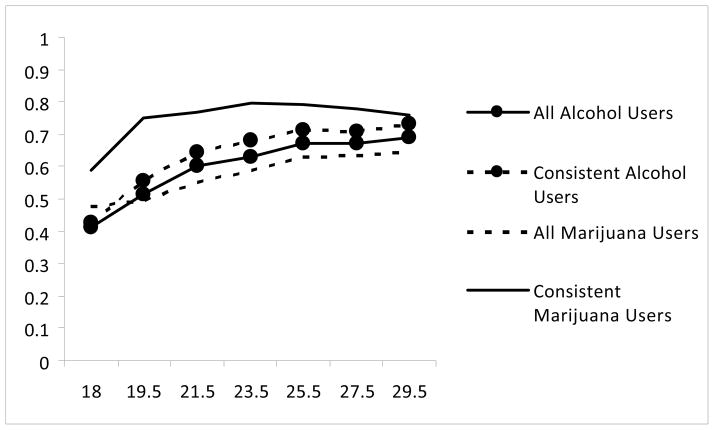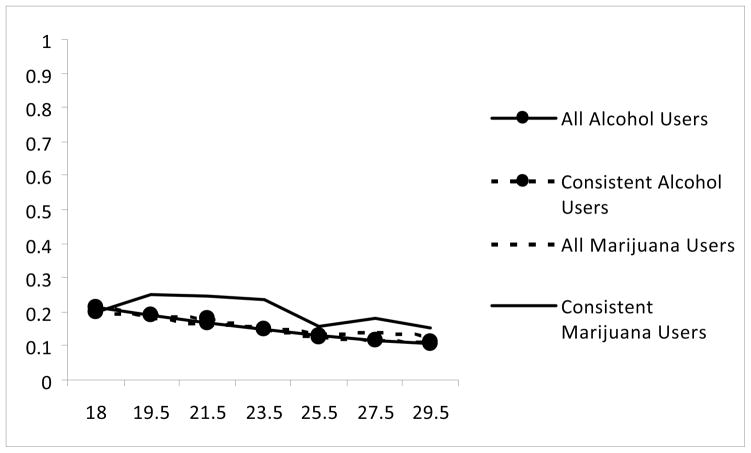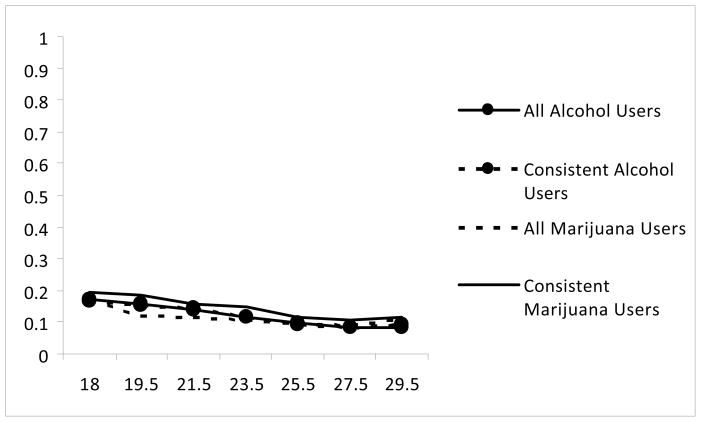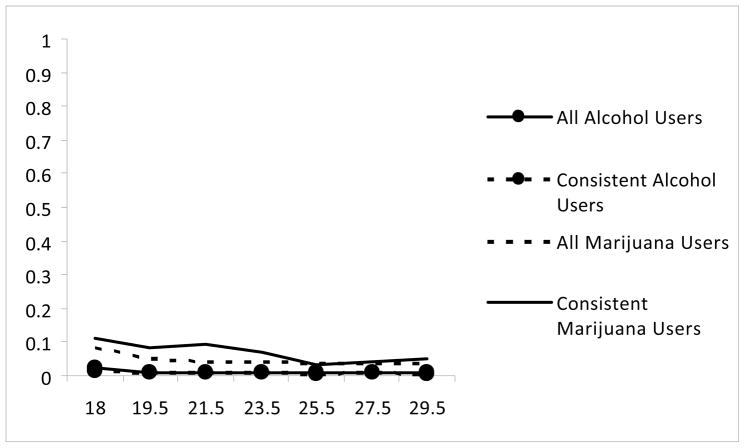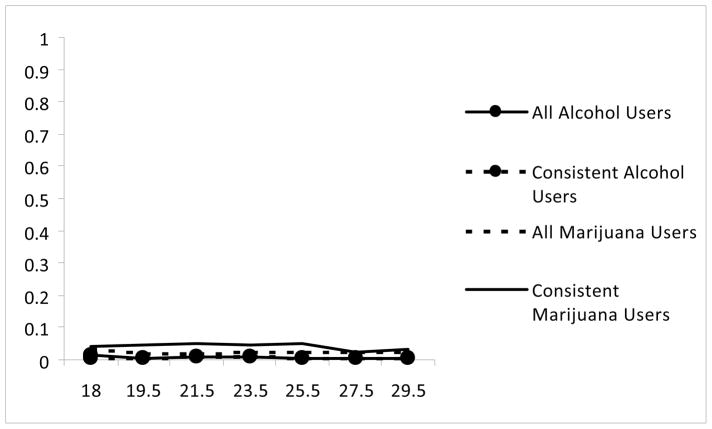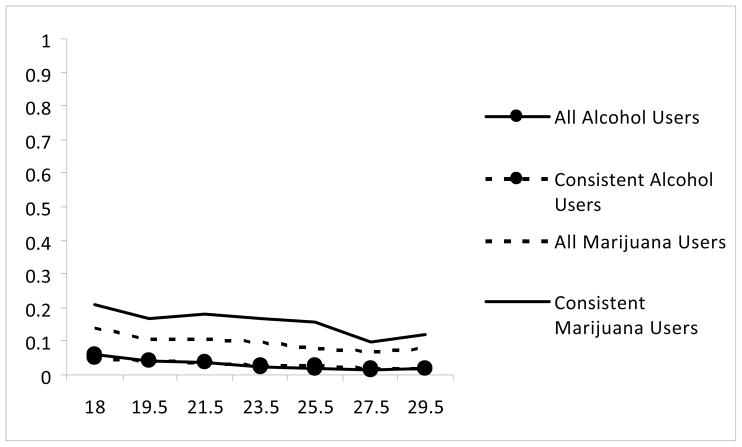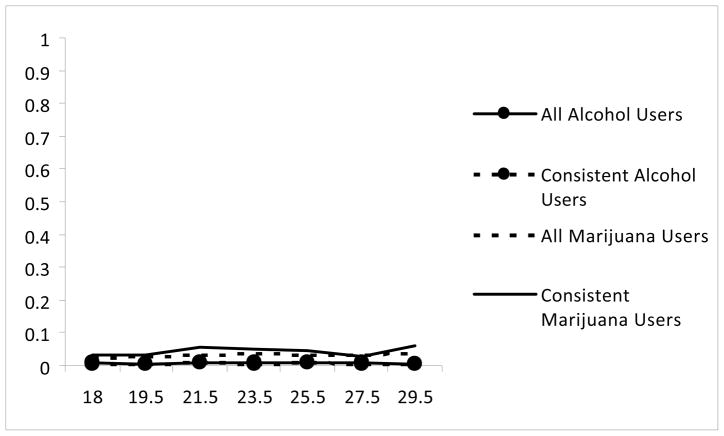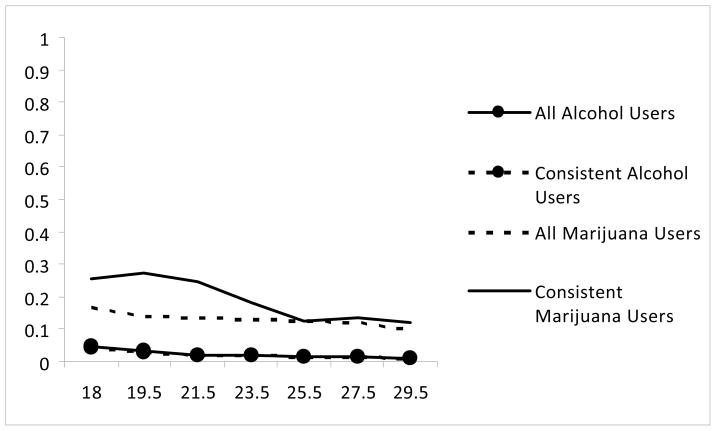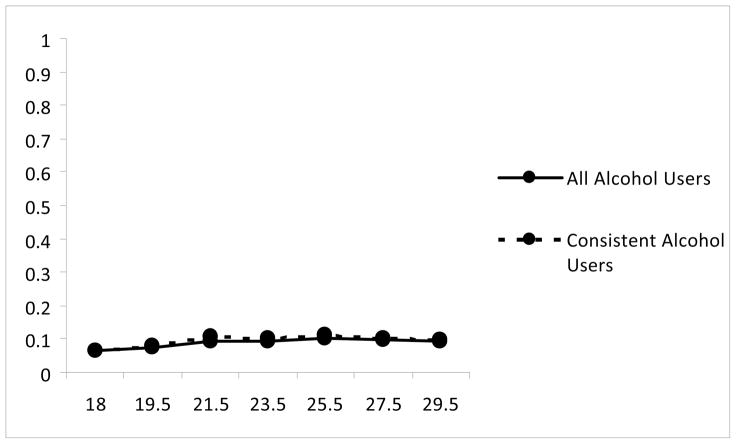Abstract
This study used up to seven waves of data from 32 consecutive cohorts of participants in the national longitudinal Monitoring the Future study to model changes in self-reported reasons for using alcohol and marijuana by age (18 to 30), gender, and recent substance use. The majority of stated reasons for use decreased in prevalence across young adulthood (e.g., social/recreational and coping with negative affect reasons); exceptions included age-related increases in using to relax (alcohol and marijuana), to sleep (alcohol), because it tastes good (alcohol), and to get high (marijuana). Women were more likely than men to report drinking for reasons involving distress (i.e., to get away from problems), while men were more likely than women to endorse all other reasons. Greater substance use at age 18 was associated with greater likelihood of all reasons except to experiment and to fit in. A better understanding of developmental changes in reasons for use is important for understanding normative changes in substance use behaviors and for informing intervention efforts involving underlying reasons for use.
Keywords: alcohol, marijuana, reasons for use, young adulthood development
As with other developmental phenomena, substance use follows a normative course across the lifespan, with individual variability. Over the past decade, considerable research has been devoted to describing and explaining trajectories of alcohol and marijuana use (Chassin, Flora, & King, 2004; Hill, White, Chung, Hawkins, & Catalano, 2000; Jackson, Sher, & Schulenberg, 2008; Patton et al., 2007; Schulenberg et al., 2005; Tucker, Ellickson, Orlando, Martino, & Klein, 2005). However, little attention has been given to what lies beneath the substance use trajectories, specifically self-perceived reasons for using substances. This paper describes self-reported reasons that motivate—use such as to get high or to have fun with friends—that likely also follow developmental patterns, with some of these reasons becoming more prevalent and others becoming very rare as individuals mature. Changes in reasons may be especially likely during the transition to adulthood when substance use peaks and then declines, and when the contexts of alcohol and other drug use shift as a function of various residential and social role transitions (Bachman et al., 2002; Schulenberg & Maggs, 2002). Despite considerable advances in understanding why individuals use alcohol and other drugs, there has been little attention to such developmental trends in these reasons for use. Our purpose is to examine developmental change in reasons for alcohol and marijuana use from age 18 through age 30, using national panel data. Addressing how reported reasons for use change with age will allow for a fuller understanding of the etiology and normative patterns in substance use behaviors across late adolescence and early adulthood.
We are not aware of any previous research that has examined age-related changes in reasons for use of alcohol or marijuana. The current study does so with a national panel sample spanning the normative lifetime peak in substance use during young adulthood. In a review of existing literature on drinking motivations, Kuntsche, Knibbe, Gmel, and Engels (2006) identified a pattern of undifferentiated drinking motivations in late childhood changing to social and enhancement motivations in adolescence, suggesting an important developmental gradient. In general, especially beyond adolescence, there has been little emphasis on developmental change in reasons for substance use. Although a developmental perspective necessitates an understanding of within-individual changes in manifest behaviors (e.g., substance use), it also requires an understanding of shifts in the underlying purposes and functions of the manifest behaviors (Schulenberg & Zarrett, 2006). Examining developmental change in the reasons individuals engage in behaviors can provide needed insight in both the persistence and desistance of the behavior, in particular to inform developmentally appropriate intervention programs that seek to include salient reasons for substance use.
Reasons for Substance
Use According to motivational models, substance use behaviors serve certain functions and meet particular needs (Cooper, 1994; Cox & Klinger, 1988; Kuntsche, Knibbe, Gmel, & Engels, 2005). Boys, Marsden, and Strang (2001) describe the functions drugs serve as the perceived gains attained by use. In other words, individuals use substances for specific reasons that relate to expected benefits. Social/recreational reasons for use of alcohol and other drugs are most common (Johnston & O’Malley, 1986; Terry-McElrath et al., 2009). The construct of self-perceived reasons for use is related to, but distinct from, the construct of expectancies. Drug use expectancies can be defined as the general beliefs individuals hold about the probability of experiencing certain consequences of a behavior (Baer, 2002; Brown, Christiansen, & Goldman, 1987; Goldman, Reich, & Darkes, 2006; Leigh, 1989; Smith, Goldman, Greenbaum, & Christiansen, 1995). Therefore, expectancies are a component of motivation (e.g., in order to drink for a given reason, one must believe alcohol leads to the desired outcome), but expectancies may not be motivating if the anticipated consequences would not be perceived as personally desirable. Although a wealth of literature has focused on motivations for alcohol use, little attention has been paid to age-related changes in these constructs. In addition, there is a paucity of research on reasons for marijuana use (Willner, 2001), both cross-sectionally and longitudinally.
Studies have previously utilized cross-sectional data on reasons for use among 12th-grade students. For example, person-centered analyses have identified classes of individuals with different profiles of reasons for alcohol use among 12th-grade students, including Experimenters (36%), Thrill-seekers (32%), Relaxers (15%), and Multi-reasoners (18%); the latter group had the greatest odds of endorsing indicators of problem drinking (e.g., drinking during the daytime, greater frequency of drunkenness) (Coffman, Patrick, Palen, Rhoades, & Ventura, 2007). In addition, reasons for use at age 18 have been shown to be significant time-invariant predictors of drug use trajectories (Jackson et al., 2008; Schulenberg, Wadsworth, O’Malley, Bachman, & Johnston, 1996) and prospective predictors of alcohol and marijuana use disorders at age 35 (Patrick, Schulenberg, O’Malley, Johnston, & Bachman, in press). To extend these person-centered and cross-sectional findings, we used longitudinal data to document the most prevalent reasons for using alcohol and marijuana across young adulthood by examining the age-related developmental changes in individual reasons for each substance from ages 18 to 30.
Differences in Reasons for Substance Use by Gender and Level of Use
Existing work documents potential differences inreasons for substance use by gender and level of substance use. In an analysis of coping, enhancement, and social motivations for drinking, adult men reported greater levels of all three types of motivations than adult women (Cooper, Frone, Russell, & Mudar, 1995). In previous work on the Monitoring the Future sample, very few gender differences in reasons were identified among 12thgraders, although substance-using women were more likely to mention anger or frustration (for alcohol and marijuana) and getting away from problems (alcohol only) as reasons for use (Johnston & O’Malley, 1986). More recently, Terry-McElrath, O’Malley, and Johnston (2009) found that men were more likely to report using substances to increase or decrease the effects of other drugs, to seek deeper insights, and because they were hooked. Women were more likely to report reasons involving coping with negative affect. Given contradictory findings regarding gender differences (particularly pertaining to coping) in reasons for drinking, and that the consistent finding that males tend to consume more alcohol and other substances (Johnston, O’Malley, Bachman, & Schulenberg, 2009; Wilsnack & Wilsnack, 2002), this study further investigates potential gender differences in the prevalence and developmental course of reasons for alcohol and marijuana use.
In addition, Johnston and O’Malley (1986) found that reasons for use varied based on level of substance use, with all reasons other than experimentation being mentioned more frequently by heavier users. Substance use at age 18 may be particularly influential, given that it co-occurs during the final year of high school and the beginning of the transition to adulthood. For example, we have shown that level of alcohol use and reasons for use at age 18 were associated with symptoms of alcohol use disorder at age 35 (Patrick, Schulenberg, O’Malley, Johnston, & Bachman, in press). Given that the extent to which individuals are using alcohol and marijuana may influence subsequent reasons for use, level of substance use at age 18 is included as a control in the models presented.
Research Questions
This study addresses three research questions using nationally representative longitudinal data from the Monitoring the Future study: (1) How do reported reasons for using alcohol and marijuana change from late adolescence through early adulthood (ages 18 to 30)? (2) Do observed changes in reasons across young adulthood differ by gender and level of substance use reported at age 18? (3) Do these patterns of change replicate across two important groups: all users (i.e., respondents who used and provided data on reasons at any given wave) and consistent users (i.e., respondents who used and provided data on reasons at all waves)? The purpose of the third research question was to replicate our results based on all users, which provide a better perspective on the general population, with analyses on consistent users, which provide a better perspective regarding within-person longitudinal patterns. Therefore, we presents findings based on all individuals who used alcohol and marijuana from ages 18 to 30 and findings based on the subset of consistent users.
Method
Participants
This study uses up to seven waves of national panel data from the Monitoring the Future (MTF) project, an ongoing study of adolescents and young adults. The project has used questionnaires administered in classrooms to survey nationally representative samples of about 16,000high school seniors each year since 1975. Starting with the class of 1976, approximately 2,400 individuals were randomly selected from each senior-year cohort for biennial follow-up via mailed questionnaires. The national MTF panel data used here consisted of 32 consecutive cohorts(classes of 1976–2007)of respondents who were surveyed as high school seniors (modal age 18) and who participated in up to six biennial follow-up surveys. The biennial follow-up surveys began one year after high school for one random half of each cohort (Waves 2–7 at modal ages 19, 21, 23, etc.) and two years after high school for the other half(Waves 2–7 at modal ages 20, 22, 24, etc.). The two random halves were combined for these analyses(Waves 2–7describe individuals at modal ages 19/20, 21/22, 23/24, 25/26, 27/28, and 29/30, respectively). Multiple questionnaire forms were used to decrease respondent burden; the forms were randomly assigned within classrooms to individuals at the first assessment. The same form was assigned to each individual in all future follow-ups. Reasons for alcohol and marijuana use central to the present analyses were included on one of the six survey forms, and only asked if participants reported use in the past year. Missing data on reasons therefore resulted from both survey non-response and no alcohol or marijuana use reported. Attrition analyses indicated that participants who remained in the study at age 30 were more likely to be White, to be women, and to report less frequent binge drinking and marijuana use at baseline.1 Drug users were oversampled for follow-up, and the sample was weighted accordingly, to approximate the original population. Further detail regarding the MTF design and procedures can be found in Bachman, Johnston, O’Malley, and Schulenberg (2006); in Johnston et al.(2009); and on the MTF website (www.monitoringthefuture.org).
The weighted sample size includes individuals across 32 cohorts who received the questionnaire form including reasons for drug use and who provided valid information on gender and past-year substance use at age 18. The analytic weighted sample for alcohol analyses with All Alcohol Users (i.e., individuals who reported reasons for alcohol use at any wave) was N = 8,955 people (52.9% female; 82.3% White, 10.4% Black, 7.3% Hispanic) and for marijuana analyses with All Marijuana Users (i.e., individuals who reported reasons for marijuana use at any wave) was N = 5,016 people (50.5% female; 84.0% White, 9.5%% Black, 6.5% Hispanic).2 Analyses were also conducted with Consistent Alcohol Users, that is, those who had complete longitudinal data and reported alcohol use in the past 12 months at each of the seven waves (i.e., individuals from cohorts 1976–1996), yielding a total of 1,673 weighted cases (55.5% female; 94.6% White, 2.7% Black, 2.7% Hispanic). Similarly, there were 172 weighted cases (42.6% female; 96.4% White, 3.2% Black, 0.4% Hispanic) of Consistent Marijuana Users (those who had complete longitudinal data and reported marijuana use in the past 12 months at each of the seven waves).
Measures
Reasons for Alcohol and Marijuana Use
At each wave, participants who indicated they had used alcohol or marijuana in the past 12 months were asked, “What have been the most important reasons for your [drinking alcoholic beverages, or using marijuana or hashish]? (Mark all that apply.)” There were 14 possible reasons for alcohol use and 13 possible reasons for marijuana use, scored dichotomously.3 In accordance with prior research using MTF measures (Johnston & O’Malley, 1986; Patrick et al., in press; Terry-McElrath et al., 2009), reasons are conceptually grouped4 into Social/Recreational Reasons (to experiment [marijuana only], to get high, to have a good time with my friends, to fit in with a group I like, because of boredom), Coping with Negative Affect Reasons (to relax, to get away from my problems, because of anger or frustration), Compulsive Use Reasons (to get through the day, because I am hooked), Drug Effect Reasons (to decrease the effects of some other drug[s], to increase the effects of some other drug[s]), and Miscellaneous Reasons (to seek deeper insights and understanding, to get to sleep [alcohol only], because it tastes good [alcohol only]).
Alcohol Use and Binge Drinking
To screen for the reasons measures (described below), participants were asked whether they had any alcoholic beverage to drink in the last 12 months. Individuals who reported they had not were instructed to skip the remaining questions regarding alcohol use, including reasons for use. Binge drinking (12thgrade, age 18) was also included in the model. The question was, “Think back over the last two weeks. How many times (if any) have you had five or more drinks in a row?” [None, Once, Twice, 3 to 5 times, 6 to 9 times, 10 or more times]. Responses were dichotomized so that 1 = binged at least once in the past two weeks and 0 = did not binge.
Marijuana Use
To screen for the reasons measures(described below), participants were asked whether they had used marijuana or hashish in the last 12 months. Past-year abstainers were asked to skip the remaining questions regarding marijuana use, including reasons for use. Past 30-day marijuana use (12thgrade, age 18) was also included in the model. The question was, “On how many occasions (if any) have you used [marijuana, or hashish] during the last 30 days” [0 Occasions, 1–2 Occasions, 3–5 Occasions, 6–9 Occasions, 10–19 Occasions, 20–39 Occasions, 40 or more]. Responses for separate questions regarding frequency of marijuana and hashish use were combined and dichotomized so that 1 = used marijuana in the past 30 days and 0 = did not use.
Cohort
Twelfth-grade cohort was coded based on known historical trends in substance use over time (Johnston et al., 2009). For alcohol use, cohort was coded as: (1) 1976–1986, (2) 1987–1993, and (3) 1994–2007. For marijuana use we broke the 1976–2007 cohorts into the following three groups: (1) 1976–1991, (2) 1992–1997, and (3) 1998–2007. Cohorts were included as dummy-codes with the earliest cohort as the reference group. These groups are based on substance-specific observed trends in age 18 levels of binge drinking and marijuana use that have been documented elsewhere (Johnston et al., 2009).
Plan of Analysis
First, the prevalences of all reasons for alcohol and marijuana use at each age were examined descriptively, as a first step in documenting possible developmental trends. Next, generalized estimating equations (GEE; Duncan, Duncan, Hops, & Stoolmiller, 1995; Lee, Herzog, Meade, Webb, & Brandon, 2007) were used to model the time-varying linear effect5 of age (Research Question 1) and the time-invariant effects of gender and substance use (i.e., binge drinking or past 30-day marijuana use) at age 18 (Research Question 2) on reasons for using alcohol and marijuana (modeled separately). GEE is an approach used to analyze longitudinal data while taking into account that shared variance results from each individual providing multiple reports. A primary benefit of GEE is the ability to include all available data at any wave(i.e., individuals with incomplete data are not excluded), so that the effects of attrition on the results are minimized. Analyses were conducted in SAS using PROC GENMOD with a REPEATED statement. The dependent variables were dichotomous indicators of reasons for use, so a binomial distribution was used with a logit link function. An autoregressive correlation structure was specified because higher correlations were expected (and found) among adjacent reports. To reduce the risk of Type I error, and given that very small (and sometimes unimportant) relations can reach significance with large sample sizes, we discuss these results using a conservative significance value of p < .001. The main effects findings in models including all users (i.e., any individuals who reported a reason at least one time at any of the seven waves) are tabled (Research Questions 1 and 2). Parallel models were conducted for consistent users (i.e., only individuals who reported reasons at all seven waves; Research Question 3), with any differences in findings reported in the text. Supplementary analyses investigated potential differences in reasons by cohort (with cohort 1 as the reference group) and by race/ethnicity (with White as the reference group).
Results
Descriptive Information Regarding Developmental Changes in Reasons
Percentage endorsements for each of the reasons for alcohol use and marijuana use are shown in Figures 1–15 (and Supplementary Tables 1 and 2). The proportion of all individuals who responded to the reasons questions at that age are shown as the All (Alcohol or Marijuana) Users, and the proportion of individuals who responded to the reasons questions at every wave are shown as the Consistent (Alcohol or Marijuana) Users. Social/Recreational reasons, except for fit in, were among the most prevalent reported reasons for use. Coping with Negative Affect Reasons were also common, especially for marijuana use. Compulsive Reasons and Drug Effect Reasons were the least prevalent, although these reasons were more often reported among marijuana users than among alcohol users. Using alcohol because it tastes good was also common. There was variability in age-related change across reasons for alcohol and marijuana, and these age effects were modeled in subsequent analyses.
Figure 1.
Prevalence of Each Reason for Alcohol and Marijuana Users
1. Experiment (asked only for marijuana across time)
Note. Age is on the x-axis and percent endorsement is on the y-axis for all figures.
Figure 15.
Prevalence of Each Reason for Alcohol and Marijuana Users
15. Tastes Good (asked only for alcohol)
Note. Age is on the x-axis and percent endorsement is on the y-axis for all figures.
Age-Related Changes in Reasons
The first research question concerned age-related changes among all users ages 18 to 30 (see Table 1). The majority of reasons decreased in prevalence with increasing age, even controlling for gender and use of the substance in question (i.e., binge drinking or marijuana use) at age 18. For alcohol use reasons, endorsement of using alcohol to relax, to sleep, and because it tastes good increased significantly with age. All other alcohol reasons decreased with age, significantly so except to decrease the effects of other drugs. Odds ratios for the effect of age on alcohol reasons ranged from 0.76 (because of boredom) to 1.24 (to relax). For marijuana use reasons, endorsement of using marijuana to get high, to relax, and to decrease the effects of other drugs increased significantly with age. All other marijuana reasons decreased with age, significantly so except for using marijuana because of being hooked. Odds ratios for the effect of age on marijuana reasons ranged from 0.64 (to experiment) to 1.17 (to relax).
Table 1.
Logistic Generalized Estimating Equations Analyses on Reasons for Alcohol and Marijuana Use Across Young Adulthood by Age, Gender, and Substance Use at Age 18
| Alcohol Use Reasons
|
Marijuana Use Reasons
|
|||||||||||
|---|---|---|---|---|---|---|---|---|---|---|---|---|
| Linear Age Trend | Male Gender | Binge Drinking (Age 18) | Linear Age Trend | Male Gender | Marijuana Use (Age 18) | |||||||
| Est(SE)
|
p
|
Est(SE)
|
p
|
Est(SE)
|
p
|
Est(SE)
|
p
|
Est(SE)
|
p
|
Est(SE)
|
P
|
|
| Social/Recreational | ||||||||||||
| Experiment | -- | -- | -- | -- | -- | -- | −0.44(.01) | .000 | −0.06(.05) | .217 | −1.03(.05) | .000 |
| Get High | −0.10(.01) | .000 | 0.11(.03) | .001 | 0.93(.03) | .000 | 0.07(.01) | .000 | 0.09(.05) | .058 | 0.95(.05) | .000 |
| Good Time | −0.08(.01) | .000 | 0.09(.03) | .008 | 0.59(.04) | .000 | −0.10(.01) | .000 | 0.21(.04) | .000 | 0.36(.04) | .000 |
| Fit In | −0.22(.01) | .000 | 0.43(.06) | .000 | −0.15(.06) | .013 | −0.19(.02) | .000 | 0.15(.07) | .036 | −0.23(.07) | .002 |
| Bored | −0.27(.01) | .000 | 0.22(.04) | .000 | 0.60(.04) | .000 | −0.16(.01) | .000 | 0.15(.05) | .004 | 0.79(.05) | .000 |
| Coping Negative Affect | ||||||||||||
| Relax | 0.22(.01) | .000 | 0.01(.03) | .707 | 0.52(.03) | .000 | 0.16(.01) | .000 | −0.01(.04) | .873 | 0.90(.04) | .000 |
| Get Away | −0.13(.01) | .000 | −0.19(.04) | .000 | 0.54(.04) | .000 | −0.11(.02) | .000 | −0.14(.05) | .011 | 0.63(.06) | .000 |
| Anger/Frustration | −0.15(.01) | .000 | −0.14(.04) | .001 | 0.64(.04) | .000 | −0.11(.02) | .000 | −0.12(.06) | .049 | 0.82(.06) | .000 |
| Compulsive Use | ||||||||||||
| Get Through Day | −0.21(.03) | .000 | 0.29(.11) | .008 | 0.72(.11) | .000 | −0.16(.02) | .000 | 0.28(.08) | .001 | 1.31(.11) | .000 |
| Hooked | −0.12(.03) | .000 | 0.93(.14) | .000 | 1.37(.16) | .000 | −0.04(.03) | .153 | 0.57(.12) | .000 | 1.70(.18) | .000 |
| Drug Effect | ||||||||||||
| Increase Effect | −0.22(.02) | .000 | 0.41(.07) | .000 | 1.14(.07) | .000 | −0.12(.02) | .000 | 0.54(.06) | .000 | 0.97(.07) | .000 |
| Decrease Effect | −0.02(.03) | .491 | 0.54(.13) | .000 | 1.25(.14) | .000 | 0.09(.02) | .000 | 0.26(.11) | .016 | 0.95(.12) | .000 |
| Miscellaneous | ||||||||||||
| Seek Insight | −0.27(.02) | .000 | 0.74(.08) | .000 | 0.44(.08) | .000 | −0.09(.02) | .000 | 0.65(.06) | .000 | 0.55(.06) | .000 |
| Sleep | 0.08(.01) | .000 | 0.28(.05) | .000 | 0.22(.05) | .000 | -- | -- | -- | -- | -- | -- |
| Tastes Good | 0.12(.01) | .000 | −0.03(.03) | .358 | 0.44(.03) | .000 | -- | -- | -- | -- | -- | -- |
Note. Each row for each substance represents a separate model. Weighted N for alcohol use reasons=8,955; weighted N for marijuana use reasons=5,016.
Differences by Gender and Substance Use
The second research question concerned whether gender and substance use at age 18 were main effect predictors of reasons for using alcohol and marijuana. Gender differences significant at p < .001 were evident for about half of the alcohol use reasons, controlling for age and binge drinking at age 18. Men were more likely than women to endorse using alcohol to get high, to fit in, because of boredom, because they were hooked, to increase effects of other drugs, to decrease effects of other drugs, to seek insight, and to sleep. Women were more likely than men to report using alcohol to get away from problems and because of anger/frustration. Odds ratios for the effect of male gender on alcohol reasons ranged from 0.82 (to get away) to 2.53 (because they were hooked). There were fewer significant gender differences in marijuana reasons. Men were more likely than women to report using marijuana to have a good time, to get through the day, because they were hooked, to decrease the effects of other drugs, and to seek insight. There were no marijuana reasons that women were significantly more likely to report. Odds ratios for the effect of male gender on marijuana reasons ranged from 0.87 (to get away; non-significant) to 1.92 (to seek insight). There were no significant Gender x Binge Drinking or Gender x Marijuana Use interactions in any of the models, indicating that the impact of substance use at age 18 on reasons did not vary by gender. Therefore, we focus on the observed main effects, and do not present interactions by gender.
Substance use at age 18 was tested as a control variable for reasons for use. Specifically, binge drinking at age 18 was included in models predicting alcohol use reasons, and marijuana use in the past 30 days at age 18 was included in models predicting marijuana use reasons, in both cases also controlling for age and gender. Age 18 binge drinkers were more likely than non-binge drinkers to report all alcohol use reasons on average across years, with the exception that using to fit in did not differ significantly at p < .001 by binge drinker status. Odds ratios for the effect of binge drinking at age 18 on alcohol reasons ranged from 0.86 (to fit in) to 3.93 (because they were hooked). Age 18 past 30-day marijuana users were more likely to report all marijuana use reasons on average across years, with the exceptions of using to experiment and to fit in. Using marijuana to experiment was significantly less likely among the more recent users than among individuals who at age 18 reported use in the past year but not in the past 30 days. Odds ratios for the effect of marijuana use at age 18 on marijuana reasons ranged from 0.36 (to experiment) to 5.48 (because they were hooked).
Age-Related Change among Consistent Users
In parallel analyses among the subset of participants who were consistent users from age 18 to 30, most of the conclusions regarding age-related effects were the same as in models with all users (Research Question 3; results not shown)based on positive or negative coefficients. In other words, the results shown among all users were replicated in a subsample of individuals who provided complete data and indicated substance use in all waves, supporting that the results reflect within-person changes in reasons over time. In all cases where coefficients differed in significance, they were such that previously significant effects from the models with all users became non-significant in the models with consistent users. This may be due to decreased power among the subset of consistent users. The alcohol use reasons of getting through the day and being hooked did not significantly change with age, and the marijuana use reasons of getting high, fitting in, getting away, and to increase/decrease the effects of other drugs did not significantly change with age at p < .001.
There were also very few gender differences in reasons for use among consistent users, controlling for age and substance use. On average, among the consistent alcohol users, men were more likely than women to report using alcohol to fit in, because of boredom, because they were hooked, to increase the effects of other drugs, to seek insight, and to sleep. Among the consistent marijuana users, there were no significant gender differences in reasons for use.
Binge drinking at age 18 was positively associated with endorsing several reasons for use among consistent alcohol users, including to get high, to have a good time, because of boredom, to relax, to get away, because of anger or frustration, to increase the effects of other drugs, to decrease the effects of other drugs, and to sleep. Among consistent users, marijuana use in the past 30 days at age 18 was a significant predictor for only one reason: marijuana use was negatively associated with using marijuana to experiment.
Differences by Cohort and Race/Ethnicity
Cohort effects (i.e., potential historical changes in reasons for use) were examined for all reasons. Across 27 tests, only a single coefficient reached significance at the p < .001 level. Drinking alcohol to get high was less prevalent among individuals in cohort 3 (i.e., 1998–2007) as compared to individuals in cohort 1 (i.e., 1976–1991). There were no cohort differences for reasons for marijuana use.
Differences by race/ethnicity were also investigated. For alcohol use, Black and Hispanic participants were less likely than Whites to report drinking to get high, to have a good time (Blacks only), to relax, and because it tastes good. Black respondents were also more likely than Whites to report drinking because of boredom. For marijuana use, Hispanics were more likely than Whites to report drinking to experiment and Blacks were more likely than Whites to report using marijuana to get high. No other differences were significant at the p < .001 level.
Discussion
Although there has been a proliferation of research on developmental changes in substance use behaviors during the transition to adulthood, few previous studies have delved deeper and documented age-related changes in reasons for use. The current study is the first to describe the normative age-related trends in reasons for alcohol and marijuana use with nationally representative longitudinal data across late adolescence and young adulthood. Overall, among individuals who used alcohol or marijuana in the prior year, the majority of reasons for use decreased in prevalence from ages 18 to 30. Notable exceptions to this pattern were an age-related increase in using both alcohol and marijuana to relax, using alcohol to sleep and because it tastes good, and using marijuana to get high. In addition, the main effects of these age-related trends were more robust than the interactions with gender and usage level, which were inconsistently demonstrated. In other words, tendencies to increase or decrease self-reported reasons were generally robust across males and females and for both binge drinkers and recent marijuana users.
A unique aspect of this study is that we conducted analyses on two important groups in our national samples, including all users (i.e., respondents who were users and provided data on reasons at any wave, thus not necessarily for all waves) and consistent users (i.e., respondents who were users and provided data at all waves). By including all users, we obtain a better sense of the general population, and by including consistent users we achieve a better sense of true within-person longitudinal patterns in a higher-risk sub-sample. The fact that we found remarkably consistent results across these two groups indicates the robustness of the developmental trends. For marijuana, using to experiment was the only reason that was more prevalent among all users than among consistent users. This is consistent with previous research that has demonstrated that using marijuana to experiment is associated with lower levels of use and fewer marijuana-related problems (Lee, Neighbors, et al., 2007). Experimentation with marijuana is likely to be more time-limited than using marijuana in order to achieve stronger effects such as altering the effects of other drug use or escaping from problems.
In general, men were likely to report more reasons for use than were women, consistent with findings regarding motivations to drink reported by Cooper et al. (1995) and data across nations and cultures showing that men drink more frequently and in greater quantities than women (Wilsnack & Wilsnack, 2002), although the gender differences among youth have been diminishing in the U.S. (Johnston et al., 2009). However, as reported previously in this sample (for age 18 only) (Terry-McElrath et al., 2009), women were more likely to report using alcohol to get away from their problems and out of anger and frustration. In other words, women were more likely than men to drink for distress-driven reasons, while men were more likely than women to drink for social/recreational, compulsive, drug effect, and miscellaneous reasons. This finding is consistent with previous research. For example, in a review of literature regarding adolescent alcohol motivations, Kuntsche et al. (2006) found a similar pattern and recommended targeting interventions for sensation-seeking boys who drink for enhancement and anxious girls who drink to cope. In addition, anxiety sensitivity was more strongly associated with coping motivations among women than among men (Stewart & Zeitlin, 1995); also, negative affect alcoholism, a subtype of alcoholism which is comorbid with depressive symptoms, is more common among women than men (Zucker, 1986). Finally, in an experience sampling study, the self-medication hypothesis was more robustly demonstrated among women than among men: women who reported greater coping motivations and alcohol-related consequences were more likely to drink immediately following periods of sadness (Hussong, 2007). Thus, what we add to this growing literature is further support that although men consume more alcohol, women may be at particular risk for using alcohol to manage emotions and experiences across late adolescence and early adulthood.
Level of substance use at age 18 also emerged as an important predictor for understanding reasons for use. For example, binge drinkers at age 18 had nearly four times the odds as non-binge drinkers of saying they used alcohol because they were hooked, and marijuana users at age 18 had nearly 5.5 times the odds of saying they used marijuana because they were hooked. Adolescent substance use and reasons for use have been shown to predict later substance use and misuse (Beseler et al., 2008; Merline et al., 2008; Patrick, Schulenberg, O’Malley, Johnston, & Bachman, in press; Patrick, Wray-Lake, Finlay, & Maggs, 2010; Zucker, 2008), and this study adds to that literature by showing that earlier substance use also predicts later reasons for use.
Strengths, Limitations, and Future Directions
An important strength of this study is the use of national panel data involving 32 cohorts across ages 18 to 30, thus speaking to the generalizibility of the normative trajectories of reasons for use across young adulthood that we identified. Such orderly decreases and increases in reasons for using alcohol and marijuana across late adolescence and early adulthood suggests that the reasons underlying substance use indeed reflect important developmental phenomena. Although the sample was large, the magnitudes of the effects were also practically meaningful. With each additional wave (i.e., 2 years), the odds of using marijuana to experiment was 64% what it had been the previous wave, exemplifying the typical decreases in reasons for use. However, using to relax increased, with 24% greater odds for using alcohol to relax and 17% greater odds for using marijuana to relax every two years. These developmental changes in the purposes and functions of substance use suggest that simply examining changes in the level of substance use is insufficient to capture how and why substance use changes (Schulenberg & Zarrett, 2006), and future research should examine the relationship between changes in reasons and changes in substance use.
An understanding of normative change in reasons is a first step toward future work modeling individual characteristics as predictors of rates of growth and decline in reasons. Future research is needed to identify dynamic changes in reasons related to trajectories of substance use and the social role transitions of college attendance, marriage, and parenthood. For example, role changes that involve more mature acceptance of adult roles may be associated with both a decline in use (Bachman et al., 2002; Staff et al., 2010) and changing reasons that reflect responsibility (e.g., decreases in using to get high). In addition, analysis of reasons for use starting prior to age 18 and how reasons for not using may change with development would meaningfully extend the findings presented here. Future analyses should investigate how normative age-related changes vary by historical cohort (Johnston & O’Malley, 1986; Palmqvist, Martikainen, & von Wright, 2003; Terry-McElrath et al., 2009).
Limitations of the current study include the dichotomous measurement of reasons for alcohol and marijuana use. Previous work on motivations and expectancies has focused on developing high-quality psychometric instruments with multi-item subscales, although these in-depth measures are often not available in large-scale, multi-topic surveys such as MTF. However, the current analysis is based on measures that capture less variation in reasons for use and therefore may underestimate population parameters. This is the first report to describe age-related changes among all alcohol and marijuana users and among consistent users of these substances from ages 18 to 30. Findings generally replicated across the full sample of substance users at any wave as well as the higher-risk subsample of consistent users at all waves, highlighting the robustness of the developmental trends. These normative trends in a national sample provide a basis for future research regarding predictors of and variation in these normative changes in reasons for use. Given that reasons for use are proximal predictors of engaging in alcohol and marijuana use, this area of research holds promise for increasing the etiological understanding of substance use behaviors and improving intervention efforts designed to reduce substance abuse and dependence across young adulthood.
Supplementary Material
Figure 2.
Prevalence of Each Reason for Alcohol and Marijuana Users
2. Get High
Note. Age is on the x-axis and percent endorsement is on the y-axis for all figures.
Figure 3.
Prevalence of Each Reason for Alcohol and Marijuana Users
3. Have a Good Time with Friends
Note. Age is on the x-axis and percent endorsement is on the y-axis for all figures.
Figure 4.
Prevalence of Each Reason for Alcohol and Marijuana Users
4. Fit In with a Group I Like
Note. Age is on the x-axis and percent endorsement is on the y-axis for all figures.
Figure 5.
Prevalence of Each Reason for Alcohol and Marijuana Users
5. Boredom
Note. Age is on the x-axis and percent endorsement is on the y-axis for all figures.
Figure 6.
Prevalence of Each Reason for Alcohol and Marijuana Users
6. Relax
Note. Age is on the x-axis and percent endorsement is on the y-axis for all figures.
Figure 7.
Prevalence of Each Reason for Alcohol and Marijuana Users
7. Get Away from Problems
Note. Age is on the x-axis and percent endorsement is on the y-axis for all figures.
Figure 8.
Prevalence of Each Reason for Alcohol and Marijuana Users
8. Anger or Frustration
Note. Age is on the x-axis and percent endorsement is on the y-axis for all figures.
Figure 9.
Prevalence of Each Reason for Alcohol and Marijuana Users
9. Get Through the Day
Note. Age is on the x-axis and percent endorsement is on the y-axis for all figures.
Figure 10.
Prevalence of Each Reason for Alcohol and Marijuana Users
10. Hooked
Note. Age is on the x-axis and percent endorsement is on the y-axis for all figures.
Figure 11.
Prevalence of Each Reason for Alcohol and Marijuana Users
11. Increase the Effect of Other Drugs
Note. Age is on the x-axis and percent endorsement is on the y-axis for all figures.
Figure 12.
Prevalence of Each Reason for Alcohol and Marijuana Users
12. Decrease the Effect of Other Drugs
Note. Age is on the x-axis and percent endorsement is on the y-axis for all figures.
Figure 13.
Prevalence of Each Reason for Alcohol and Marijuana Users
13. Seek Insight
Note. Age is on the x-axis and percent endorsement is on the y-axis for all figures.
Figure 14.
Prevalence of Each Reason for Alcohol and Marijuana Users
14. Sleep (asked only for alcohol)
Note. Age is on the x-axis and percent endorsement is on the y-axis for all figures.
Acknowledgments
Data collection for this study was funded by support from the National Institute on Drug Abuse (R01 DA 01411). The content here is solely the responsibility of the authors and does not necessarily represent the official views of the sponsors.
Footnotes
Similarly, previous attrition analyses have shown that participants who remain in the panel study through age 24 are more likely to be White; women; higher on high school grade point average, college plans, and parental education level; and lower on high school truancy and senior-year substance use in comparison to attriters (Bachman et al., 2006; Schulenberg, Bachman, O’Malley, & Johnston, 1994; Schulenberg et al., 1996).
Respondents differed in the number of waves of data on reasons that were available. For alcohol reasons, 22.5% (N=2015) had 1 wave,14.5% (N=1294) had 2 waves, 11.0% (N=989) had 3 waves, 10.1% (N=903) had 4 waves, 10.4% (N=932) had 5 waves, 12.9% (N=1150) had 6 waves, and 18.9% (N=1673) had 7 waves. For marijuana reasons, 42.1% (N=2114) had 1 wave, 21.8% (N=1092) had 2 waves, 13.3% (N=669) had 3 waves, 8.6% (N=433) had 4 waves, 6.1% (N=305) had 5 waves, 4.6% (N=231) had 6 waves, and 3.4% (N=172) had 7 waves.
The reason “to experiment” was included in all of the longitudinal marijuana assessments, but only for alcohol use at age 18 and is therefore not included in these longitudinal analyses for alcohol use reasons. Two reasons—“to get to sleep” and “because it tastes good”—were assessed as reasons for alcohol use but not marijuana use.
The items were designed to represent a wide range of reasons in a broad national survey, rather than to reflect underlying latent psychological constructs. Consistent with this, exploratory factor analysis indicated that items were largely independent (Johnston & O’Malley, 1986). However, for presentation purposes, they are grouped based on the four types of motivations that have been theoretically and empirically differentiated for alcohol use in prior research: obtaining social rewards (i.e., social), enhancing positive affect (i.e., enhancement), reducing negative affect (i.e., coping), and avoiding social alienation (i.e., conformity; Cooper, 1994; Cox & Klinger, 1988). Studies on marijuana use motivations have assessed similar domains to allow comparison across substances (Lee, Neighbors, & Woods, 2007; Simons, Correia, & Carey, 2000).
The quadratic effect of age was significant for only 8 out of 27 reasons: to experiment (marijuana), to get high (alcohol), to have a good time (alcohol), to relax (alcohol and marijuana), to get through the day (alcohol), to sleep (alcohol), and for the taste (alcohol). When these quadratic effects were included in the models, the interpretation of the results was nearly identical, with very few exceptions. The linear effect of age was no longer significant for using alcohol to get high or for using marijuana to have a good time, because of boredom, to increase the effect of another drug, and to seek insight. No other differences were found.
References
- Bachman JG, Johnston LD, O’Malley PM, Schulenberg JE. The Monitoring the Future project after thirty-two years: Design and procedures (Monitoring the Future Occasional Paper No. 64) Institute for Social Research; Ann Arbor, MI: 2006. [Google Scholar]
- Bachman JG, O’Malley PM, Schulenberg JE, Johnston LD, Bryant AL, Merline AC. The decline of substance use in young adulthood: Changes in social activities, roles, and beliefs. Mahwah, NJ: Lawrence Erlbaum; 2002. [Google Scholar]
- Baer JS. Student factors: Understanding individual variation in college drinking. Journal of Studies on Alcohol & Drugs. 2002;(Suppl 14):40–53. doi: 10.15288/jsas.2002.s14.40. [DOI] [PubMed] [Google Scholar]
- Beseler CL, Aharonovich E, Keyes KM, Hasin DS. Adult transition from at-risk drinking to alcohol dependence: The relationship of family history and drinking motives. Alcoholism: Clinical and Experimental Research. 2008;32:607–616. doi: 10.1111/j.1530-0277.2008.00619.x. [DOI] [PMC free article] [PubMed] [Google Scholar]
- Boys A, Marsden J, Strang J. Understanding reasons for drug use among young people: A functional perspective. Health Education Research. 2001;16:457–469. doi: 10.1093/her/16.4.457. [DOI] [PubMed] [Google Scholar]
- Brown SA, Christiansen BA, Goldman MS. The Alcohol Expectancy Questionnaire: An instrument for the assessment of adolescent and adult alcohol expectancies. Journal of Studies on Alcohol. 1987;48:483–491. doi: 10.15288/jsa.1987.48.483. [DOI] [PubMed] [Google Scholar]
- Chassin L, Flora DB, King KM. Trajectories of alcohol and drug use and dependence from adolescence to adulthood: The effects of familial alcoholism and personality. Journal of Abnormal Psychology. 2004;113:483–498. doi: 10.1037/0021-843X.113.4.483. [DOI] [PubMed] [Google Scholar]
- Coffman D, Patrick ME, Palen L, Rhoades BL, Ventura AK. Why do high school seniors drink? Implications for a targeted approach. Prevention Science. 2007;8:241–248. doi: 10.1007/s11121-007-0078-1. [DOI] [PubMed] [Google Scholar]
- Cooper ML. Motivations for alcohol use among adolescents: Development and validation of a four-factor model. Psychological Assessment. 1994;6:117–128. [Google Scholar]
- Cooper ML, Frone MR, Russell M, Mudar P. Drinking to regulate positive and negative emotions: A motivational model of alcohol use. Journal of Personality & Social Psychology. 1995;69:990–1005. doi: 10.1037//0022-3514.69.5.990. [DOI] [PubMed] [Google Scholar]
- Cox WM, Klinger E. A motivational model of alcohol use. Journal of Abnormal Psychology. 1988;92:168–180. doi: 10.1037//0021-843x.97.2.168. [DOI] [PubMed] [Google Scholar]
- Duncan TE, Duncan SC, Hops H, Stoolmiller M. An analysis of the relationship between parent and adolescent marijuana use via generalized estimating equation methodology. Multivariate Behavioral Research. 1995;30:317–339. doi: 10.1207/s15327906mbr3003_2. [DOI] [PubMed] [Google Scholar]
- Goldman MS, Reich RR, Darkes J. Expectancy as a unifying construct in alcohol-related cognition. In: Wiers RW, Stacy AW, editors. Handbook of implicit cognition and addiction. Thousand Oaks, CA: Sage; 2006. pp. 105–120. [Google Scholar]
- Hill KG, White HR, Chung IJ, Hawkins JD, Catalano RF. Early adult outcomes of adolescent binge drinking: Person-and variable-centered analyses of binge drinking trajectories. Alcoholism, Clinical & Experimental Research. 2000;24:892–901. [PMC free article] [PubMed] [Google Scholar]
- Hussong AM. Predictors of drinking immediacy following daily sadness: An application of survival analysis to experience sampling data. Addictive Behaviors. 2007;32:1054–1065. doi: 10.1016/j.addbeh.2006.07.011. [DOI] [PMC free article] [PubMed] [Google Scholar]
- Jackson KM, Sher KJ, Schulenberg JE. Conjoint developmental trajectories of young adult substance use. Alcoholism, Clinical & Experimental Research. 2008;32:1–15. doi: 10.1111/j.1530-0277.2008.00643.x. [DOI] [PMC free article] [PubMed] [Google Scholar]
- Jager J, Schulenberg JE, O’Malley PM, Bachman JG. Historical variation in rates of change in substance use across the transition to adulthood: The trend towards lower intercepts and steeper slopes. doi: 10.1017/S0954579412001228. in preparation. [DOI] [PMC free article] [PubMed] [Google Scholar]
- Johnston LD, O’Malley PM. Why do the nation’s students use drugs and alcohol? Self-reported reasons from nine national surveys. Journal of Drug Issues. 1986;16:29–66. [Google Scholar]
- Johnston LD, O’Malley PM, Bachman JG, Schulenberg JE. Secondary school students(NIH Publication No. 09-7402) I. Bethesda, MD: National Institute on Drug Abuse; 2009. Monitoring the Future national survey results on drug use, 1975–2008. [Google Scholar]
- Kuntsche E, Knibbe R, Gmel G, Engels R. Why do young people drink? A review of drinking motives. Clinical Psychology Review. 2005;25:841–861. doi: 10.1016/j.cpr.2005.06.002. [DOI] [PubMed] [Google Scholar]
- Kuntsche E, Knibbe R, Gmel G, Engels R. Who drinks and why? A review of socio-demographic, personality, and contextual issues behind the drinking motives in young people. Addictive Behaviors. 2006;31:1844–1857. doi: 10.1016/j.addbeh.2005.12.028. [DOI] [PubMed] [Google Scholar]
- Lee CM, Neighbors C, Woods BA. Marijuana motives: Young adults’ reasons for using marijuana. Addictive Behaviors. 2007;32:1384–1394. doi: 10.1016/j.addbeh.2006.09.010. [DOI] [PMC free article] [PubMed] [Google Scholar]
- Lee J, Herzog TA, Meade CD, Webb MS, Brandon TH. The use of GEE for analyzing longitudinal binomial data: A primer using data from a tobacco intervention. Addictive Behaviors. 2007;32:187–193. doi: 10.1016/j.addbeh.2006.03.030. [DOI] [PubMed] [Google Scholar]
- Leigh BC. In search of the seven dwarves: Issues of measurement and meaning in alcohol expectancy research. Psychological Bulletin. 1989;105:361–373. doi: 10.1037/0033-2909.105.3.361. [DOI] [PubMed] [Google Scholar]
- Merline AC, Jager J, Schulenberg JE. Adolescent risk factors for adult alcohol use and abuse: Stability and change of predictive value across early and middle adulthood. Addiction. 2008;103(Suppl 1):84–99. doi: 10.1111/j.1360-0443.2008.02178.x. [DOI] [PMC free article] [PubMed] [Google Scholar]
- Newcomb MD, Chou C, Bentler PM, Huba GJ. Cognitive motivations for drug use among adolescents: Longitudinal test of gender differences and predictors of change in drug use. Journal of Counseling Psychology. 1988;35:426–438. [Google Scholar]
- Palmqvist RA, Martikainen LK, von Wright MR. A moving target: Reasons given by adolescents for alcohol and narcotics use, 1984 and 1999. Journal of Youth & Adolescence. 2003;32:195–203. [Google Scholar]
- Patrick ME, Schulenberg JE, O’Malley PM, Johnston L, Bachman J. Adolescents’ reported reasons for alcohol and marijuana use as predictors of substance use and abuse in middle adulthood. Journal of Studies on Alcohol and Drugs. doi: 10.15288/jsad.2011.72.106. in press. [DOI] [PMC free article] [PubMed] [Google Scholar]
- Patrick ME, Wray-Lake L, Finlay AK, Maggs JL. The long arm of expectancies: Adolescent alcohol expectancies predict adult alcohol use. Alcohol and Alcoholism. 2010;45:17–24. doi: 10.1093/alcalc/agp066. [DOI] [PMC free article] [PubMed] [Google Scholar]
- Patton GC, Coffey C, Lynskey MT, Reid S, Hemphill S, Carlin JB, et al. Trajectories of adolescent alcohol and cannabis use into young adulthood. Addiction. 2007;102:607–615. doi: 10.1111/j.1360-0443.2006.01728.x. [DOI] [PubMed] [Google Scholar]
- Schulenberg JE, Bachman JG, O’Malley PM, Johnston LD. High school educational success and subsequent substance use: A panel analysis following adolescents in young adulthood. Journal of Health & Social Behavior. 1994;35(1):45–62. [PubMed] [Google Scholar]
- Schulenberg JE, Maggs JL. A developmental perspective on alcohol use and heavy drinking during adolescence and the transition to young adulthood. Journal of Studies on Alcohol. 2002;(Supplement 14):54–70. doi: 10.15288/jsas.2002.s14.54. [DOI] [PubMed] [Google Scholar]
- Schulenberg JE, Merline AC, Johnston LD, O’Malley PM, Bachman JG, Laetz VB. Trajectories of marijuana use during the transition to adulthood: The big picture based on national panel data. Journal of Drug Issues. 2005;35(2):255–279. doi: 10.1177/002204260503500203. [DOI] [PMC free article] [PubMed] [Google Scholar]
- Schulenberg JE, Wadsworth KN, O’Malley PM, Bachman JG, Johnston LD. Adolescent risk factors for binge drinking during the transition to young adulthood: Variable-and pattern-centered approaches to change. Developmental Psychology. 1996;32:659–674. [Google Scholar]
- Schulenberg JE, Zarrett NR. Mental health during emerging adulthood: Continuity and discontinuity in courses, causes, and functions. In: Arnett JJ, Tanner JL, editors. Emerging adults in America: Coming of age in the 21st century. Washington, DC: American Psychological Association; 2006. pp. 135–172. [Google Scholar]
- Staff J, Schulenberg JE, Maslowsky J, Bachman JG, O’Malley PM, Maggs JL, Johnston LD. Substance use changes and social role transitions: Proximal developmental effects on ongoing trajectories from late adolescence through early adulthood. Development and Psychopathology. 2010;22:917–932. doi: 10.1017/S0954579410000544. [DOI] [PMC free article] [PubMed] [Google Scholar]
- Simons J, Correia CJ, Carey KB. A comparison of motives for marijuana and alcohol use among experienced users. Addictive Behaviors. 2000;25:153–160. doi: 10.1016/s0306-4603(98)00104-x. [DOI] [PubMed] [Google Scholar]
- Smith GT, Goldman MS, Greenbaum PE, Christiansen BA. Expectancy for social facilitation from drinking: The divergent paths of high-expectancy and low-expectancy adolescents. Journal of Abnormal Psychology. 1995;104:32–40. doi: 10.1037//0021-843x.104.1.32. [DOI] [PubMed] [Google Scholar]
- Stewart SH, Zeitlin SB. Anxiety sensitivity and alcohol use motive. Journal of Anxiety Disorders. 1995;9:229–240. [Google Scholar]
- Terry-McElrath YM, O’Malley PM, Johnston LD. Reasons for drug use among American youth by consumption level, gender, and race/ethnicity: 1976–2005. Journal of Drug Issues. 2009 Summer;:677–714. doi: 10.1177/002204260903900310. [DOI] [PMC free article] [PubMed] [Google Scholar]
- Tucker JS, Ellickson PL, Orlando M, Martino SC, Klein DJ. Substance use trajectories from early adolescence to emerging adulthood: A comparison of smoking, binge drinking, and marijuana use. Journal of Drug Issues. 2005;35:307–331. [Google Scholar]
- Willner P. A view through the gateway: Expectancies as a possible pathway from alcohol to cannabis. Addiction. 2001;96:691–703. doi: 10.1046/j.1360-0443.2001.9656915.x. [DOI] [PubMed] [Google Scholar]
- Wilsnack SC, Wilsnack RW. International gender and alcohol research: Recent findings and future directions. Alcohol Research & Health. 2002;26:245–250. [PMC free article] [PubMed] [Google Scholar]
- Zucker RA. The four alcoholisms: A developmental account of the etiologic process. Nebraska Symposium on Motivation. 1986;34:27–83. [PubMed] [Google Scholar]
- Zucker RA. Anticipating problem alcohol use developmentally from childhood into middle adulthood: What have we learned? Addiction. 2008;103(Suppl 1):100–108. doi: 10.1111/j.1360-0443.2008.02179.x. [DOI] [PMC free article] [PubMed] [Google Scholar]
Associated Data
This section collects any data citations, data availability statements, or supplementary materials included in this article.



